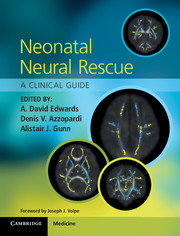Book contents
- Frontmatter
- Contents
- List of contributors
- Foreword
- Section 1 Scientific background
- Section 2 Clinical neural rescue
- Section 3 The future
- 18 Novel neuroprotective therapies
- 19 Combining hypothermia with other therapies for neonatal neuroprotection
- 20 Biomarkers for studies of neuroprotection in infants with hypoxic–ischaemic encephalopathy
- Index
- References
20 - Biomarkers for studies of neuroprotection in infants with hypoxic–ischaemic encephalopathy
from Section 3 - The future
Published online by Cambridge University Press: 05 March 2013
- Frontmatter
- Contents
- List of contributors
- Foreword
- Section 1 Scientific background
- Section 2 Clinical neural rescue
- Section 3 The future
- 18 Novel neuroprotective therapies
- 19 Combining hypothermia with other therapies for neonatal neuroprotection
- 20 Biomarkers for studies of neuroprotection in infants with hypoxic–ischaemic encephalopathy
- Index
- References
Summary
Introduction
Trials of mild hypothermia have recently proved in principle that neuroprotective therapy after delivery is possible but the protection is only partial and additional therapies are needed [1–3]. There are several candidate treatments suitable for trial (see Chapter 18) and the challenge is how to test several therapies efficiently so that only those with a high chance of success progress to pragmatic phase 3 trials. The major costs of large randomized trials mean that it is essential that only treatments with a high chance of success are studied; indeed while the financial costs are often obvious, the opportunity cost is equally if not more important. Every patient enrolled in a trial of a useless therapy is excluded from a trial of one that might work, so ill-advised major trials are a significant drag on progress in the field. It is notable that 11 years elapsed between the first demonstration that post-asphyxial hypothermia modified perinatal hypoxic-ischaemic encephalopathy in animals and the first evidence of a clinical benefit in newborn infants.
This is a familiar problem in drug development which is usually solved by testing an agent in small and rapid phase 2 studies which employ biological markers or surrogate outcomes to define a biological effect and provide evidence to support and plan pragmatic studies. However, these intermediary endpoints have to be used with circumspection as they are not substitutes for proof of clinical benefit, merely an experimental tool for efficient study of new treatments [4].
- Type
- Chapter
- Information
- Neonatal Neural RescueA Clinical Guide, pp. 219 - 228Publisher: Cambridge University PressPrint publication year: 2013



